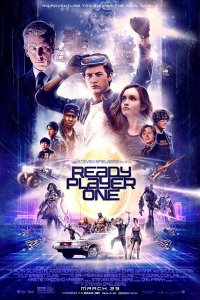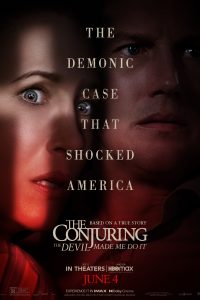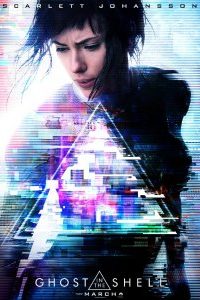Midnight at the OASIS: Gary Westfahl Reviews Ready Player One
 Audiences will probably enjoy watching Steven Spielberg’s Ready Player One, but they won’t necessarily feel proud of themselves for doing so. Rather, they will recognize that they have paid some money to participate in a thrilling, fast-paced, but essentially empty adventure – much like the arcade video games that, in the film, have eventually engendered the immense virtual universe of OASIS.
Audiences will probably enjoy watching Steven Spielberg’s Ready Player One, but they won’t necessarily feel proud of themselves for doing so. Rather, they will recognize that they have paid some money to participate in a thrilling, fast-paced, but essentially empty adventure – much like the arcade video games that, in the film, have eventually engendered the immense virtual universe of OASIS.
The film has been faithful to the basic premise and overall structure of Ernest Cline’s 2011 novel: in the year 2045, the late James Halliday (Mark Rylance), creator of OASIS, embedded a series of “Easter eggs” within that virtual universe and announced that the first person who is able to follow his clues and find all of them will inherit his vast fortune and control of OASIS. (Could this be why they decided to open the film on Easter weekend?) Young Wade Watts (Tye Sheridan), aka Parzival, is competing to win the prize along with numerous other individuals and the sinister corporation Innovative Online Industries, headed by Nolan Sorrento (Ben Mendelsohn), who wishes to ruin OASIS by turning it into an exploitative profit-making machine. However, with the aid of some eventual allies – Art3mis (Olivia Cooke), Aech (Lena Waithe), Sho (Philip Zhao), and Daito (Win Morisaki) – Parzival fortunately seems destined to win the game.
However, almost all of the specific events in the novel have been altered, usually for discernible reasons. In the novel, Parzival first lives in Oklahoma City, Aech is in Pittsburgh, and Art3mis lives in Vancouver, requiring the sudden intervention of Halliday’s former partner, Odgen Morrow (Simon Pegg), to get them together in the real world; for purposes of efficient storytelling, the film places them all in Columbus, Ohio from the start. Adding some cuteness to the picture, the novel’s adult Shoto has been recast as the eleven-year-old Sho. Since audiences don’t like to read, the brief email that Parzival sends out in the novel to rally gamers to his cause has been replaced by an interminable inspirational speech. To get the keys in the novel, Parzival is usually required to win some ancient video game or recite dialogue from a 1980s movie, but since this would not make for exciting cinema, these tasks have largely been replaced by more action-packed challenges, like a car race through a virtual New York City that involves dodging the blows of Godzilla and King Kong and a frenetic zero-gravity dance. One aspect of the novel has been interestingly downplayed: Cline describes at length how, in the future, people with debts can be forced to become indentured laborers, and when Parzival suffers this fate, he know that in theory he can earn enough money to pay his debts and earn his freedom, but so many fees and penalties are regularly imposed that no one can ever escape. The film does show Art3mis briefly dragooned into such service, but little is said about the issue of debt – perhaps because, today, there is increasing concern about debt collectors cleverly using the courts to throw debtors into prison, even though the practice is officially outlawed, so the novel’s prescient penalties might arouse controversy.
The innumerable references to films, television shows, and video games from the 1970s and 1980s that permeate the novel have mostly been excised, so as to avoid perplexing or irritating filmgoers who are not familiar with them, and undoubtedly fearing that nobody today remembers films like Monty Python and the Holy Grail (1975) or WarGames (1983), the screenwriters instead place the film’s Parzival within the world of an older film that people are still watching, Stanley Kubrick’s The Shining (1980). Finally, because Hollywood loves to contrive violent confrontations between virtuous heroes and loathsome villains, the film has expanded Sorrento’s role and provided him with two henchmen: I-r0k (T. J. Miller), only an annoying wannabe in the novel, has been reconfigured as a virtual thug, hired to do Sorrento’s dirty work within OASIS, while a new character, F’Nale Zandor (Hannah John-Kamen), handles his nefarious business in the real world.
More broadly, and more disappointingly, Cline’s novel has been dumbed down to better appeal to the masses. The novel, more than anything, is a fond celebration of being a nerd; Parzival is clearly a bright but socially awkward young man who has amassed an encyclopedic knowledge of the popular culture of the 1980s, both because that will help him win Halliday’s contest and because he genuinely enjoys old arcade games like Joust and old movies like Ladyhawke (1985). Halliday’s clues are ingeniously complex, and to figure them out, Parzival must rely upon his intellect, not his physical prowess as an avatar. In contrast, Sheridan’s Parzival doesn’t seem particularly smart, and he doesn’t seem particularly knowledgeable; the film’s clues are much less complicated, leading one to wonder why they weren’t solved a few weeks after Halliday’s death; and Parzival sometimes must triumph by clobbering an opponent instead of outwitting him. In the novel, Parzival crafts an elaborate and cunning scheme to break into IOI’s databases; in the film it’s basically the result of a lucky break. It’s interesting that the film entirely omits the novel’s accounts of Wade’s experiences in the virtual high school that he attends, as if to convey that people don’t need to be educated in order to succeed in this version of OASIS.
In addition – and here is where Spielberg’s thumbprints are most visible – the film has taken a message that only fleetingly surfaces in the novel and bluntly brought it to the forefront: video games and virtual worlds may be diverting, but the most important thing is spending time in the real world, because, as Halliday brilliantly observes, “reality is the only thing that’s real.” Not content to merely preach this gospel, the film’s Parzival even plans to force people to spend less time in OASIS and more time in reality. In this way, the film seems at odds with itself: on one hand, audiences are supposed to delight in the visual splendor and nonstop excitement provided by OASIS, but they are ultimately instructed that they must abandon all of this in order to embrace a life in the dreary slums of Columbus.
There is even the suggestion that the whole purpose of OASIS – and Halliday’s contest – is to bring people together to forge real-world friendships and relationships. “The contest is all about connecting,” Parzival exclaims at one point, and Morrow sagely intones that “OASIS was never supposed to be a one-player game.” Arguably, the novel makes this point in describing one challenge that can only be overcome when three players are simultaneously engaged; yet the film omits that sequence in order to emphasize Parzival’s and Art3mis’s single-handed heroics. It is also worth noting that the most “connected” people in the novel and film are villains – the numerous experts and operatives hired by IOI to collectively solve the puzzles and win the contest.
Still, despite the muted focus on nerdiness and its excessive moralizing, the film does manage to preserve some of the spirit and ambience of Cline’s novel – largely because the screenwriters were Cline himself and Zak Penn, best known for authoring superhero movies. The novel’s obscure works of 1970s and 1980s popular culture may have been replaced by more obvious choices, but though they are less frequent, they remain part of the fabric of the film: within OASIS, one can observe Batman, Marvin the Martian, the Iron Giant, Mobile Suit Gundam, a Rubik’s Cube, and a Magic 8-Ball, and there are verbal or visual references to Star Trek and Star Wars, films like Saturday Night Fever (1977), Animal House (1978), The Adventures of Buckaroo Banzai Across the Eighth Dimension (1984), Back to the Future (1985), The Breakfast Club (1985), Ferris Bueller’s Day Off (1986), and Child’s Play (1988), and early video games like Space Invaders (1978) and Adventure (1979). (I’m not sure why the film also includes a quotation from a much older film, It’s a Wonderful Life [1946] – “no man is a failure who has friends” – but it was in the 1980s that this once-forgotten film suddenly became everybody’s favorite Christmas movie, and modern screenwriters can rarely resist the opportunity to add one more bromide to their scripts.)
While there is that fleeting reference to Star Trek, and while the credits list the “Robot” from Lost in Space (1965-1968), I never saw him, and I recall no other mention of television programs – because television is perceived as film’s chief competitor? However, filmmakers notoriously love to recycle old rock songs in their films, and Spielberg has no aversion to choices that underline aspects of the plot with absolutely no subtlety at all – here, the Temptations’ “Just My Imagination (Running Away with Me)” (1971), Prince’s “I Wanna Be Your Lover” (1979), Hall and Oates’s “You Make My Dreams Come True” (1981), Twisted Sister’s “We’re Not Gonna Take It” (1984) , George Michael’s “Faith” (1987), and Joan Jett and the Blackhearts’ “I Hate Myself for Loving You” (1988). (In the spirit of not avoiding the obvious, it’s surprising that the scene where Parzival and Art3mis are dancing in a virtual nightclub was not accompanied by Maria Muldaur’s “Midnight at the Oasis” [1973]). Also, dressing up for a date, Parzival tries out the looks of Michael Jackson’s “Thriller” (1982) and Duran Duran. Some of these references may be especially appreciated by certain filmgoers; as a long-time fan of giant monster movies, for example, I was particularly pleased to see that the film retained the scene in the novel when Sorrento mounts a virtual Mechagodzilla, and as the behemoth marches into battle, we can hear the iconic Godzilla theme that has accompanied the monster’s appearance in almost all of his films.
All of this does raise one question: why should the popular culture of the 1970s and 1980s be so central to a 2011 novel and 2018 film? There is an obvious element of autobiography: both Cline and his character Halliday were born in 1972, so they would naturally cherish the films and video games of their youth; co-screenwriter Penn was born around the same time, in 1968; and while Spielberg was already a young adult in the 1970s and 1980s, he must look back on that period with special fondness, since that was the time that he went from being an obscure television director to the most acclaimed filmmaker in the world. It’s also true that predicting future technology is often easy enough, but it is difficult if not impossible to predict the future’s popular culture, so science fiction writers will sometimes fall back on positing an implausible future revival of interest in old, familiar works; further, these can have helpful resonances for writers and viewers that invented future works would lack. Thus, it is perfectly correct for Stephen P. Brown to complain that the affection Allan Steele’s future space residents have for the music of the Grateful Dead is as silly as imagining modern people obsessively devoted to the melodies of Glenn Miller; but Steele was employing that Grateful Dead music to convey key aspects of his characters’ personalities in a succinct and evocative manner. Similarly, one could argue that Cline’s references to works once popular with bright young teenagers are serving as an appropriate accompaniment to a story about bright young teenagers in the future.
Yet there is a particular reason why a story about overachieving young people might turn to the popular culture of the 1970s and 1980s as its ideal backdrop; for this was the time when children first became dominant figures in a changing media landscape. Up until 1980 or so, adults were the experts on everything, and children constantly had to turn to their parents for information and guidance. Then there appeared newfangled gadgets like video games and personal computers, and as they grew up with them, children and teenagers effortlessly mastered all of their quirks and intricacies, while most adults struggled to adjust to the new technology. So, when computers and similar devices became central to everyday life, young people became the world’s most important experts. Thus, when I was a child, I cannot recall a single time when my parents ever asked me for help with anything, but as adults, my wife and I regularly turn to our children for assistance when our computer freezes or our smartphone isn’t working. People may say that “youth culture” first emerged in the 1960s, but all of those protesters and hippies never garnered any real power; it was only in the 1980s that young people truly conquered the world.
The novel Ready Player One, in part, is the chronicle of one young man of that era, James Halliday, who employed his skill in creating video games to become one of the richest and most prominent people in the world; it is also the story of a future young man with similar proclivities, Wade Watts, who is destined to become one of the richest and most prominent people in the world of the future. And, if you think about it, some of the referenced films, like Back to the Future, The Breakfast Club, and Ferris Bueller’s Day Off, are basically about young people who prove that they are smarter and more capable than their elders, and the novel has an extended description of the film offering the ultimate portrait of youthful empowerment, WarGames: “I, David Lightman, a teenage computer geek from suburban Seattle, had single-handedly prevented the end of human civilization.” While reviewing other films like The Hunger Games: Mockingjay – Part I (2014 – review here) and The 5th Wave (2016 – review here), I have noted the recent trend of improbably portraying virtuous youths as humanity’s future saviors, but this novel and film place that story in a context where it actually makes sense.
A final question to ponder is whether this novel and film represent an accurate prediction: living in the sorts of miserable, impoverished futures that are now the norm in science fiction films, will the vast majority of citizens really choose to spend almost all of their time within attractive virtual environments, requiring someone like Parzival to issue a clarion call for them to get back to living in the real world? I have my doubts. Certainly, in my own case, I continue to prefer standard films to their 3-D and IMAX equivalents, I feel no desire to investigate the crude forms of virtual reality that are now available, I only use my smartphone to make calls and send texts, and at times (gasp!) I still read books. So, I suspect that virtual worlds like OASIS will not become virulent addictions but rather just another entertainment option that some people will choose and some people will ignore. Sure, it might be fun to visit OASIS for a few hours, but I would never want to live there, and I face the future with no fears that the world is about to lose touch with reality.
Directed by Steven Spielberg
Written by Zak Penn and Ernest Cline, based on the novel by Ernest Cline
Starring Tye Sheridan, Olivia Cooke, Ben Mendelsohn, Lena Waithe, T. J. Miller, Simon Pegg, Mark Rylance, Philip Zhao, Win Morisaki, Hannah John-Kamen, Ralph Ineson, Susan Lynch, Clare Higgins, Laurence Spellman, and Perdita Weeks
Gary Westfahl has published 26 books about science fiction and fantasy, including Science Fiction Quotations: From the Inner Mind to the Outer Limits (2005), The Spacesuit Film: A History, 1918-1969 (2012), and A Sense-of-Wonderful Century: Explorations of Science Fiction and Fantasy Films (2012); excerpts from these and his other books are available at his World of Westfahl website (here). He has also published hundreds of articles, reviews, and contributions to reference books. His most recent books are the three-volume A Day in a Working Life: 300 Trades and Professions through History (2015), An Alien Abroad: Science Fiction Columns from Interzone (2016), and the co-edited Bridges to Science Fiction and Fantasy: Outstanding Essays from the J. Lloyd Eaton Conferences (2018). His forthcoming books include Arthur C. Clarke, part of the University of Illinois Press’s Modern Masters of Science Fiction series.







